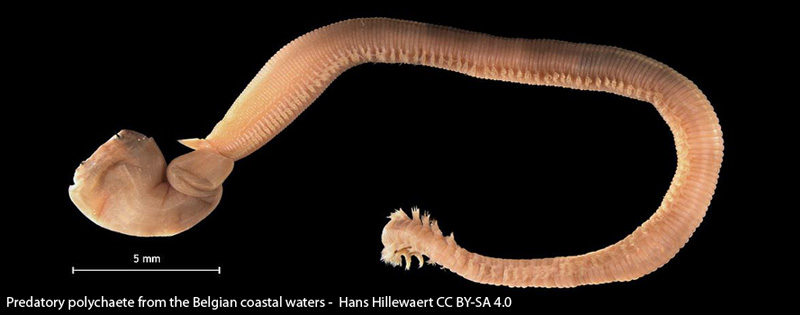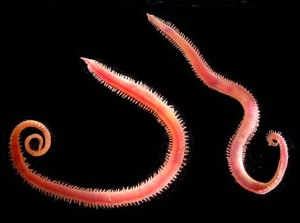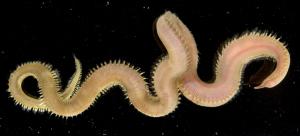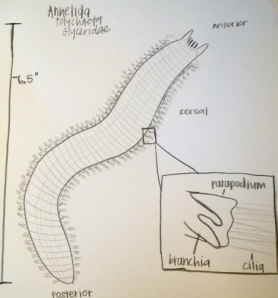Long-term MLSSA member Brian Brock says that he has been interested in Palolo worms since his early student days at the University of Adelaide. According to Britannica , Palolo worms are segmented marine worms of the families Eunicidae and Nereidae (class Polychaeta, phylum Annelida). Their breeding behaviour is unique. During the breeding season, at the same time of year and a particular phase of the Moon, the worms break in half. The tail section (the “epitoke”) bearing reproductive cells, swims to the surface, where it releases eggs and sperm. Tens of thousands of epitokes swarm and release gametes simultaneously, attracting predatory fish and humans. The front section of the worm (the “atoke”) remains below in the substrate.
Brian writes:
“Professor Andrewartha was one of my ecology lecturers. There is discussion of the periodicity of swarming in relation to phases of the moon in Andrewartha HG & Birch LC, 1954; “The Distribution & Abundance of Animals” (Uni. of Chicago Press) pages 300-305.
When teaching science at Martyrs Memorial School, Papua in 1964, I was fortunate to find an article in the July 1962 South Pacific Bulletin by F. Tofa Iiga Pisa titled “The rising of the Palolo”, (pages 24-26). The swarming parts of the worms are considered to be a culinary delight in Samoa.
In our own Port (Adelaide) River estuary, we see the swarming of the segmented worm Glycera Americana. Ken Jury’s fishing notes in The Advertiser, 1-8-80 & 7-8-81, and Jon Huie’s of 18-7-86 (The Advertiser) & 6-7-97 (Sunday Mail) discuss the Blood Worm run and its effect on the fishing scene.
The swarming takes place “Each year on the dark phase of the moon in July . . . .” (Jon Huie, p.142 Sunday Mail 6/7/97).
I have not seen the swarming, but hope to look at the anatomy of a worm or two sometime; they have an eversible pharynx armed with four jaws with which they can catch prey. Gut content would be interesting.
Clear drawings of the front end of Glycera americana with the pharynx* everted can be seen in Tyler MJ, Twidale CR & Ling JK (Editors), 1979, “Natural History of Kangaroo Island” (Royal Society of South Australia) p.157 fig. 1 G, and Shepherd SA & Thomas IM (1982) “Marine Invertebrates of Southern Australia Part I” (Government Printer SA) p.254 fig. 6.10 A (mlssa Nos. 1023 & 1021 respectively).
* (The caption for fig. 1 G, p.157 of “Natural History of Kangaroo Island” (drawn by Lesley Howard) reads “’proboscis’ everted”.)
The pointy front end of the animal and diminutive tentacles and the four teeth can be seen. A more spectacular drawing, showing internal anatomical details of the pharynx, is fig. 10-15C on p.246 of Barnes RD (1974) “Invertebrate Zoology” (WB Saunders Coy.). The species of Glycera is not specified for 10-15C.”
“Natural History of Kangaroo Island” edited by Tyler MJ, Twidale CR & Ling JK (Royal Society of South Australia) 1979 has a section regarding bristle worms in the chapter on Intertidal Invertebrates. It says that blood worms (Glycerid) “have long slender bodies and are sharply conical anteriorly. They possess a long, cylindrical, readily eversible pharynx at the end of which are four black teeth.”
It goes on to say “They appear to be carnivorous although some species are said to be detritus feeders.”
That was the belief in 1979. (According to Marine Life Information Network (MarLIN) (1997), “The Glycera sp. are active carnivorous polychaetes which prey upon smaller annelids and amphipods”. Much of the literature on the subject, however, seems to be divided on this topic. According to “Shores and Shallows of Coffin Bay – An Identification Guide” by B. Saunders, (mlssa No.1071), “The Blood Worm (Glycera sp.) spends most of its life below the sand where it hunts invertebrates. It emerges to swim at the time of mass spawning. There is a long and powerful eversible pharynx which terminates in four black teeth. The worm everts the pharynx forceably into the sand when burrowing or taking prey.” There are three photos accompanying this text.
“Natural History of Kangaroo Island” also says “Glycera Americana . . . is often collected in the sand and mud flats at American River* and Muston.”
* (Not the reason behind the name of the species, which is known, amongst other names, as the American bloodworm.)
Details regarding Glycera americana can be found in the book “Intertidal Invertebrates of California” by Robert Hugh Morris (1980). Details can also be found in Wikipedia . Google has photos of the species.
This photo of the species can be found on Google : –
Glycera americana
(Source: http://researcharchive.calacademy.org/research/izg/SFBay2K/Glyceraamericana64527A.jpg)
This other smaller photo of the species can be found at Cell circulation in branchiae of Glycera americana : –
Glycera americana
(Source: https://invertzoology.wordpress.com/2013/07/18/cell-circulation-in-branchiae-of-glycera-americana/ )
There is also this illustration of the species on that same web page: –
Illustration of Glycera americana
(With a close up of a parapodium and its associated branchia)
(Source: https://invertzoology.wordpress.com/2013/07/18/cell-circulation-in-branchiae-of-glycera-americana/ )
There is a further illustration on the web page, plus some short video footage (Which can also be found on YouTube). More video footage seems to be available on YouTube, including some showing Glycera americana being dissected.
According to WoRMS (World Register of Marine Species), the classification of Glycera americana is as follows: –
Annelida (Phylum)
Polychaeta (Class)
Errantia (Subclass)
Phyllodocida (Order)
Glyceriformia (Suborder)
Glyceridae (Family)
Glycera (Genus)
Glycera americana (Species)
Our thanks go to Brian Brock for bringing this species to our attention.





Brian Brock says that the diagram of Glycera americana (with a close up of a parapodium and its associated branchia) taken from https://invertzoology.wordpress.com/2013/07/18/cell-circulation-in-branchiae-of-glycera-americana/ “is not at all clear”. “For clear drawings of Glycera americana showing the pointed front end of the worm, & its small tentacles, everted pharynx, & four black teeth or jaws, go to Thomas, IM & SJ Edmonds “Intertidal Invertebrates”, fig.1G on page 157 of Tyler MJ, CR Twidale & JK LIng (1979) “Natural History of Kangaroo Island” (Royal Society of South Australia). Equally clear is fig.6.10 A ->C of Pat Hutching’s chapter on Brittleworms (Phylum Annelida) in Shepherd SA & Thomas IM (1982) “Marine Invertebrates of Southern Australia Part I” (Government Printer SA). I have yet to find decent specimens & do my own drawings of Glycera americana (Blood Worms),” he said.